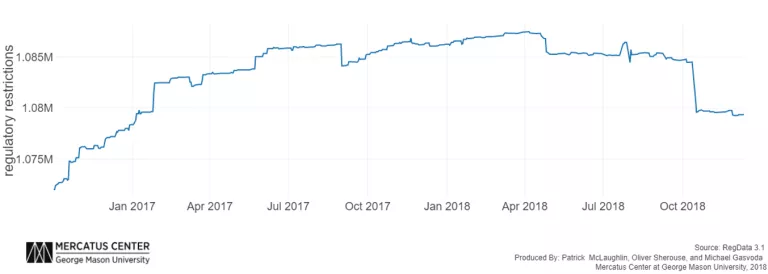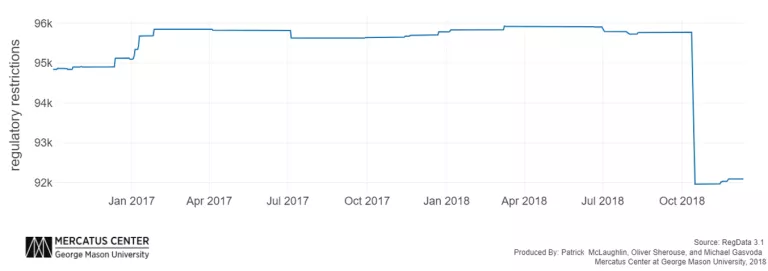- | Regulation Regulation
- | Expert Commentary Expert Commentary
- |
Obsolete Regulations and Regulatory Reform in Washington
We continue monitoring regulatory data as we approach the two-year anniversary of Executive Order 13771—the order issued by President Trump that established what’s colloquially known as the “one-in, two-out” regulatory reform policy. Over on QuantGov.org, you can track the stock of federal regulations in close to real-time. Figure 1 shows the most recent data, and immediately obvious in that figure is that something “big” happened in October of 2018. That dip represents the largest discrete drop in the regulatory restrictions data for the Trump administration so far. The October drop-off entailed the removal of approximately 4,900 regulatory restrictions, most of which stem from the removal of regulations related to the now-defunct Office of Thrift Supervision (OTS) and outdated regulations related to a teacher grant program that is no longer in operation.
Figure 1: Total Regulatory Count During Trump Administration

The Office of Thrift Supervision was once a major regulatory office established following the savings and loan crisis of the 1980s and 1990s. It was abolished in 2011 when its role was transferred to other agencies upon the passage of the Dodd-Frank Wall Street Reform and Consumer Protection Act. However, its rules remained on the books until the United States Department of the Treasury formally removed them in October. This one day drop in regulatory count due to the elimination of redundancies in the federal regulatory code accounts for approximately five percent of all regulations under the Department of the Treasury (see figure 2).
Figure 2: Regulatory Count for the US Department of the Treasury

Removing regulations, particularly those which are obsolete, represents a simple path towards reducing the complexity, uncertainty, and overall burden of the regulatory code. In fact, despite the Trump administration’s efforts at regulatory reform—efforts which have notably not only slowed the growth of regulation but as of October have actually begun to reduce the total stock of regulatory restrictions on the books—it would still take a person reading as a full-time job three years, 108 days, five hours, and five minutes to read through the entire code of federal regulations. It seems like an obvious and uncontroversial win to eliminate regulations that are no longer in effect, which is exactly what happened in October.
Photo credit: Tasos Katapodis/Getty Images